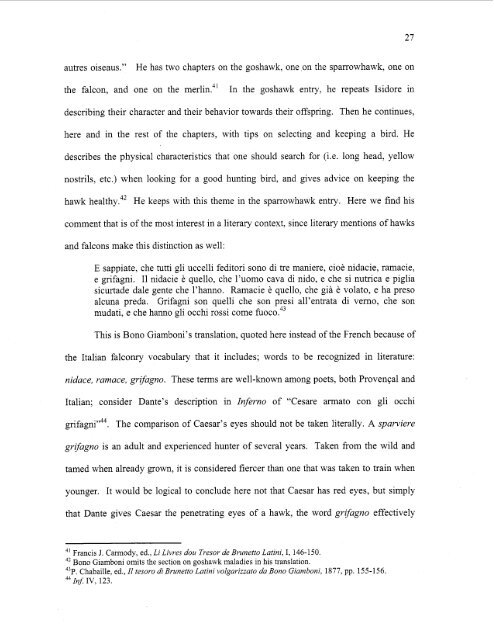Birds of Prey and the Sport of Falconry in Italian Literature through ...
Birds of Prey and the Sport of Falconry in Italian Literature through ...
Birds of Prey and the Sport of Falconry in Italian Literature through ...
You also want an ePaper? Increase the reach of your titles
YUMPU automatically turns print PDFs into web optimized ePapers that Google loves.
autres oiseaus." He has two chapters on <strong>the</strong> goshawk, one,on <strong>the</strong> sparrowhawk, one on<br />
<strong>the</strong> falcon, <strong>and</strong> one on <strong>the</strong> merli~~.~' In <strong>the</strong> goshawk entry, he repeats Isidore <strong>in</strong><br />
describ<strong>in</strong>g <strong>the</strong>ir character <strong>and</strong> <strong>the</strong>ir behavior towards <strong>the</strong>ir <strong>of</strong>fspr<strong>in</strong>g. Then he cont<strong>in</strong>ues,<br />
here <strong>and</strong> <strong>in</strong> <strong>the</strong> rest <strong>of</strong> <strong>the</strong> chapters, with tips on select<strong>in</strong>g <strong>and</strong> keep<strong>in</strong>g a bird. He<br />
describes <strong>the</strong> physical characteristics that one should search for (i.e. long head, yellow<br />
nostrils, etc.) when look<strong>in</strong>g for a good hunt<strong>in</strong>g bird, <strong>and</strong> gives advice on keep<strong>in</strong>g <strong>the</strong><br />
hawk healthy." He keeps with this <strong>the</strong>me <strong>in</strong> <strong>the</strong> sparrowhawk entry. Here we f<strong>in</strong>d his<br />
comment that is <strong>of</strong> <strong>the</strong> most <strong>in</strong>terest <strong>in</strong> a literary context, s<strong>in</strong>ce literary mentions <strong>of</strong> hawks<br />
<strong>and</strong> falcons make this dist<strong>in</strong>ction as well:<br />
E sappiate, che tutti gli uccelli feditori sono di tre maniere, cioe nidacie, ramacie,<br />
e grifagni. I1 nidacie e quello, che l'uomo cava di nido, e che si nutrica e piglia<br />
sicurtade dale gente che l'hanno. Ramacie e quello, che gia e volato, e ha preso<br />
alcuna preda. Grifagni son quelli che son presi all'entrata di verno, che son<br />
mudati, e che hanno gli occhi rossi come f bo~o.~~<br />
This is Bono Giamboni's translation, quoted here <strong>in</strong>stead <strong>of</strong> <strong>the</strong> French because <strong>of</strong><br />
<strong>the</strong> <strong>Italian</strong> falconry vocabulary that it <strong>in</strong>cludes; words to be recognized <strong>in</strong> literature:<br />
nidace, ramace, grifagno. These terms are well-known among poets, both Provengal <strong>and</strong><br />
<strong>Italian</strong>; consider Dante's description <strong>in</strong> Inferno <strong>of</strong> "Cesare armato con gli occhi<br />
grifagni"44. The comparison <strong>of</strong> Caesar's eyes should not be taken literally. A sparviere<br />
grifagno is an adult <strong>and</strong> experienced hunter <strong>of</strong> several years. Taken from <strong>the</strong> wild <strong>and</strong><br />
tamed when already grown, it is considered fiercer than one that was taken to tra<strong>in</strong> when<br />
younger. It would be logical to conclude here not that Caesar has red eyes, but simply<br />
that Dante gives Caesar <strong>the</strong> penetrat<strong>in</strong>g eyes <strong>of</strong> a hawk, <strong>the</strong> word grifagno effectively<br />
4' Francis J. Carmody, ed., Li Livres dou Tresor de Brunetto Lat<strong>in</strong>i, I , 146-150.<br />
42 Bono Giamboni omits <strong>the</strong> section on goshawk maladies <strong>in</strong> his translation.<br />
4 3 ~ Chabaille, . ed., I1 tesoro di Brunetto Lat<strong>in</strong>i volgarizzato da Bono Giamboni, 1877, pp. 155-156.<br />
44 In$ IV? 123.


